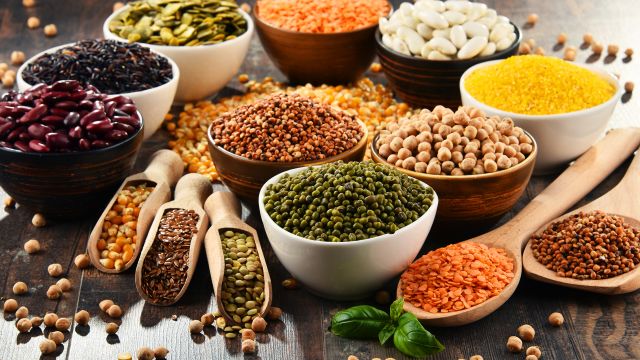Updated on March 5, 2024.
You might’ve heard the news: Cutting back on meat and eating mostly plant-based foods can lower blood pressure and reduce your risk of chronic illnesses including stroke, heart disease, type 2 diabetes, and many cancers. And adding legumes to your diet can help you make the switch.
Legumes are the filling, protein-rich food group that includes beans, peas, and lentils. Here's why they're a valuable addition to almost any healthy eating plan.
What are legumes?
Legumes are a type of vegetable whose seed grows inside of a pod. They come in countless colors, textures, and flavors, each offering unique health benefits. In fact, there are over 16,000 types of legumes, including:
- Black, white, pinto, and kidney beans
- Garbanzo beans (chickpeas)
- Soybeans (edamame)
- Lentils
- Peas
Despite this rich variety, less than 5 percent of Americans consume legumes on any given day. On average, however, we each eat more than 83 pounds of beef, 67 pounds of pork, and 112 pounds of chicken per year.
Remarkable nutritional benefits of legumes
Like meat, legumes can fill you up and add protein to your plate. But, unlike meat, they contain zero cholesterol and little to no saturated fat, explains Jessica Bocquin, RD, LD, a registered dietitian nutritionist in Overland Park, Kansas.
“Not only are legumes cholesterol-free, they’re also high in vitamins and minerals such as folate, potassium, iron, and magnesium,” says Bocquin. “And while they’re lower in fat, the fats that they do contain are heart-healthy unsaturated fats. They're also high in fiber, which supports healthy digestion and helps to lower levels of low-density lipoprotein (aka LDL or 'bad' cholesterol).”
About 90 percent of U.S. women and 97 percent of men do not get enough fiber in their diets, according to government experts. For women, the daily recommended allowance is between 22 and 28 grams each day, depending on age. If you’re pregnant or lactating, it ranges from 28 to 36 grams. For men, it’s between 28 to 34 grams.
Adding legumes into your daily diet makes it easier to meet this daily goal. A 1/2 cup of cooked lentils offers 7.8 grams of fiber, while the same amount of navy beans offers 9.6 grams of fiber. The USDA recommends eating 1 1/2 to 3 cups of cooked beans weekly.
How can adding more legumes to your diet help you live longer?
“Legumes can help you make a more satisfying meal with less fat, which promotes a healthy weight,” says Bocquin. “Since people who are overweight are more likely to develop illnesses like heart disease, diabetes, a number of cancers, and depression, eating a lean diet can help you avoid life-threatening illnesses. It also lets you reduce the amount of meat in your diet, which lowers your risk of heart disease.”
Simple ways to add legumes to your diet
Here are some quick-and-easy tips to help you eat more legumes:
If you’re worried about bloating: Use dry beans, soak them overnight, and then rinse them before cooking. Just be sure to cook your beans in fresh, new water.
If you’re craving a savory, superfood snack: “Hummus is even better when you make it on your own. It’s so easy, just combine garlic, garbanzo beans (chickpeas), tahini (a paste made from ground sesame seeds), and some lemon juice. Add roasted red peppers or basil for optional extra flavor. Throw it in the food processor, dip some warm pita and you’ve got a filling, healthy snack,” recommends Bocquin.
If you want a healthier version of taco night: Mix together low-sodium black beans, salsa, and low-fat cream cheese. Pour the mixture over lettuce for a hearty taco salad.
If you make meat on taco night: Mix refried beans in with your taco meat, suggests Bocquin. That way, you’ll get more than one type of protein on your plate, and you won’t need to take as much meat per serving.
Still not convinced that you need more beans in your life? They’re good for your wallet as well as your health.
“Beans are very inexpensive when you compare them to other protein sources,” says Bocquin. A pound of dried pinto beans typically costs around $1 and makes 12 servings of cooked beans at 1/2 cup each. A pound of ground beef can cost $5 or more. So, if the health perks of mostly plant-based eating aren't compelling enough, consider the benefits for your budget.







